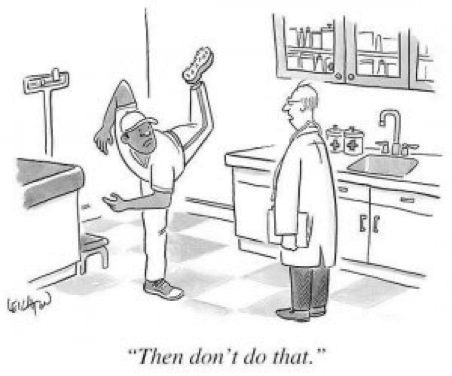Have you ever been in the middle of an ACL rehab session and feel an ache or pain? It’s completely normal if it’s something small and goes away. It’s another story if it continues to bother you or increase in pain.
Sometimes we just do too much (or too little) and it pisses off some part of our body.
You may start to realize it’s impacting the way you move and you may even avoid a particular movement that causes the pain altogether.
Often times, people see this as a sign to take some time off and rest. This may be the case in some instances, but it’s not always the best solution.
Some people go to a healthcare professional to find out what’s going on. Quite frequently, they’re told to stop that activity or exercise. We hear it all the time from new patients.
“Squats are bad for your knees.”
“Running will wreck your body.”
“Stop doing CrossFit. You’ll get hurt.”

[Credit: Barbell Physio]
But, what if you’re an Olympic weightlifter who has a competition coming up? What if you’re a runner who loves a good 5k? What if you have a stressful job and CrossFit is your outlet to relieve that stress?
Come on healthcare, we can do better.
If these are your goals, we want to help you get there.
Here’s 5 different ways to train around pain and decrease stress on that painful area.
- Weight
- Range
- Tempo
- Variation
- Different Exercise
MAIN GOAL: MAKE THE LEAST CHANGES POSSIBLE TO THE MOVEMENT
Now, let’s break down each one of these using knee pain with front squats as an example.
1. Weight
- This could be as simple as decreasing the weight.
- Example: Your knee pain starts when you hit 185 in your front squat, but not at 155. Dial it back, work at 155 and build back up over time.
2. Range
- Change or decrease the range of motion. We use partial range of motion all the time in rehab as way to regress a movement.
- Example: Your knee pain occurs at the bottom position of your front squat. Limit your depth to ¾ of the range, squat to a box or med ball.

[Credit: EricCressey.com]
3. Tempo
- This is an incredibly underutilized variable in training. You can’t load much weight, but can still do the movement. Tempos allow you to create time under tension and strength through different ranges of the movement – whether that’s lowering, pausing, and/or raising during the movement. We call these the eccentric, isometric, and concentric phases of a muscle contraction, respectively.
- Example: Knee pain only occurs at 90 degrees. You can try utilizing isometric holds in that position for 30-45 seconds or doing a 3-2-3 count where you do a 3 second eccentric, 2 second isometric hold, and 3 second concentric movement. The options here are endless.
4. Variation
- Use a different variation of the movement – you’re still training the same movement pattern (squat), but changing up where the load and stress is placed.
- Example: Front squats bring on your knee pain, then try a back squat, box squat, goblet squat, zercher squat, or a spanish squat.

[Credit: Barbell Rehab]
5. Different Exercise
- Try a completely different exercise to help get the same training stimulus for that muscle.
- Example: Instead of a squat variation to train your quadriceps (front thigh muscle), you do seated knee extensions, lunges or step ups.
Here are a few other examples for you:
- Back pain with conventional deadlift:
- Weight: decrease
- Range: elevate on blocks
- Tempo: pause
- Variation: sumo
- Different Exercise: glute bridges
- Foot pain with running:
- Weight: decrease speed/intensity
- Range: decrease running distance
- Tempo: walk/run, interval
- Variation: sprints, uphill running, downhill running
- Different Exercise: cycling
- Shoulder pain with bench press:
- Weight: decrease
- Range: floor press
- Tempo: 3 second eccentric
- Variation: single arm dumbbell press
- Different Exercise: Pushup
Here’s the overall concept:
Pain comes on→ scale back movement slightly → train movement → adapt → progress difficulty → adapt → back to prior level → continue training pain-free hit PR
I believe that any great coach or physical therapist should be able to modify and progress/regress any movement or activity.
If you have given these methods a shot and pain continues to impact your life, then find a healthcare professional who understands your goals and doesn’t tell you to stop.

